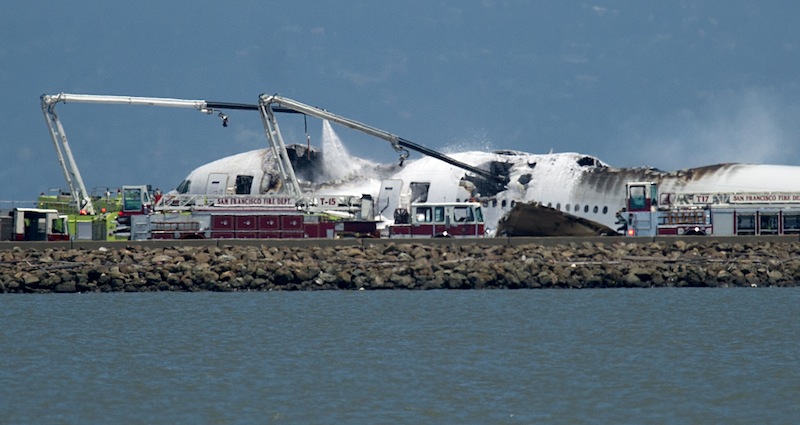Updated 7:38 P.M. E.T.
SAN FRANCISCO (AP) — An Asiana Airlines flight from Seoul, South Korea, crashed while landing at San Francisco International Airport on Saturday, killing at least two people, injuring dozens of others and forcing passengers to jump down the emergency inflatable slides to safety as flames tore through the plane.
In addition to the two deaths in the crash at San Francisco International Airport, dozens of passengers were unaccounted for, said San Francisco Fire Chief Joanne Hayes-Whites.
“This is a work in progress,” she said, adding the investigation has been turned over to the FBI and that terrorism has been ruled out. She said at least 48 people were initially transported from the scene to area hospitals.
The Federal Aviation Administration said Flight 214 crashed while landing before noon PDT. A video clip posted to YouTube showed smoke coming from a jet on the tarmac. Passengers could be seen jumping down the emergency slides.
Television footage showed the top of the fuselage was burned away and the entire tail was gone. One engine appeared to have broken away. Pieces of the tail were strewn about the runway. Emergency responders could be seen walking inside the burned-out wreckage.
It wasn’t immediately clear what happened to the plane as it was landing, but some eyewitnesses said the aircraft seemed to lose control and that the tail may have hit the ground.
Stephanie Turner saw the plane going down and the rescue slides deploy, but returned to her hotel room before seeing any passengers get off the jet, she told ABC News. Turner said when she first saw the flight she noticed right away that the angle of its approach seemed strange.
“I mean we were sure that we had just seen a lot of people die. It was awful,” she said. “And it looked like the plane had completely broken apart. There were flames and smoke just billowing.”
Kate Belding was out jogging just before 11:30 a.m. on a path the water from the airport when she noticed the plane approaching the runway in a way that “just didn’t look like it was coming in quite right.”
“Then all of a sudden I saw what looked like a cloud of dirt puffing up and then there was a big bang and it kind of looked like the plane maybe bounced (as it neared the ground),” she said. “I couldn’t really tell what happened, but you saw the wings going up and (in) a weird angle.”
“Not like it was cartwheeling,” she said, but rather as though the wings were almost swaying from side to side.
Doug Yakel, a spokesman for the airport, said he did not yet know how many passengers were aboard the flight. “We also don’t have any information at this time to the status of those passengers,” he said at a brief news conference.
San Francisco General Hospital spokeswoman Rachael Kagan said the adult patients range in age from 20 to their 40s. It was not immediately clear the ages of the children.
San Francisco-area broadcasters KNTV, KCBS and KTVU have reported that there were fatalities in Saturday’s crash, but The Associated Press contacted police, fire and coroner’s officials and was unable to confirm any deaths.
A call to the airline seeking comment wasn’t immediately returned.
The National Transportation Safety Board said it was sending a team of investigators to San Francisco to probe the crash. NTSB spokeswoman Kelly Nantel said Saturday that NTSB Chairman Deborah Hersman would head the team.
Boeing said it was preparing to provide technical assistance to the NTSB.
Numerous flights headed to San Francisco were diverted to other airports. A United Airlines flight bound for San Francisco was sent to Los Angeles airport, and passengers were told the San Francisco airport would be closed for at least three hours Saturday afternoon.
Asiana is a South Korean airline, second in size to national carrier Korean Air. It has recently tried to expand its presence in the United States, and joined the Star Alliance, which is anchored in the U.S. by United Airlines.
The 777-200 is a long-range plane from Boeing. The twin-engine aircraft is one of the world’s most popular long-distance planes, often used for flights of 12 hours or more, from one continent to another. The airline’s website says its 777s can carry between 246 to 300 passengers.
The flight was 10 hours and 23 minutes, according to FlightAware, a flight tracking service. The aircraft is configured to seat 295 passengers, it said.
The Boeing 777 is a smaller, wide-body jet that can travel long distances without refueling and is typically used for long flights over water.
The most notable accident involving a 777 occurred on Jan. 17, 2008 at Heathrow Airport in London. British Airways Flight 28 landed hard about 1,000 feet short of the runway and slid onto the start of the runway. The impact broke the 777-200’s landing gear. There were 47 injuries, but no fatalities.
An investigation revealed ice pellets that had formed in the fuel were clogging the fuel-oil heat exchanger, blocking fuel from reaching the plane’s engines. The Rolls-Royce Trent 800 series engines that were used on the plane were then redesigned.
Bill Waldock, an expert on aviation accident investigation, said he was reminded of the Heathrow accident as he watched video of Saturday’s crash. “Of course, there is no indication directly that’s what happened here,” he said. “That’s what the investigation is going to have to find out.”
The Asiana 777 “was right at the landing phase and for whatever reason the landing went wrong,” said Waldock, director of the Embry-Riddle University accident investigation laboratory in Prescott, Ariz. “For whatever reason, they appeared to go low on approach and then the airplane pitched up suddenly to an extreme attitude, which could have been the pilots trying to keep it out of the ground.”
The last time a large U.S. airline lost a plane in a fatal crash was an American Airlines Airbus A300 taking off from John F. Kennedy International Airport in New York in 2001.
Smaller airlines have had crashes since then. The last fatal U.S. crash was a Continental Express flight operated by Colgan Air, which crashed into a house near Buffalo, N.Y. on Feb. 12, 2009. The crash killed all 49 people on board and one man in a house.
Flying remains one of the safest forms of transportation: There are about two deaths worldwide for every 100 million passengers on commercial flights, according to an Associated Press analysis of government accident data.
Just a decade ago, passengers were 10 times as likely to die when flying on an American plane. The risk of death was even greater during the start of the jet age, with 1,696 people dying — 133 out of every 100 million passengers — from 1962 to 1971. The figures exclude acts of terrorism.
Asia remains one of the fastest-growing regions for aviation in the world. Even with slowing economies in Japan and China, airlines there saw 3.7 percent more passengers than a year ago, according to the International Air Transport Association.
Finding enough experienced pilots to meet a growing number of flights is becoming a problem. A 2012 report by aircraft manufacturer Boeing said the industry would need 460,000 new commercial airline pilots in the next two decades — with 185,000 of them needed in Asia alone.
“The Asia-Pacific region continues to present the largest projected growth in pilot demand,” the report said.
___
Associated Press writers Joan Lowy in Washington, D.C., Scott Mayerowitz in New York and Pauline Arrillaga in Phoenix contributed to this report.
Copyright 2013 The Associated Press.










